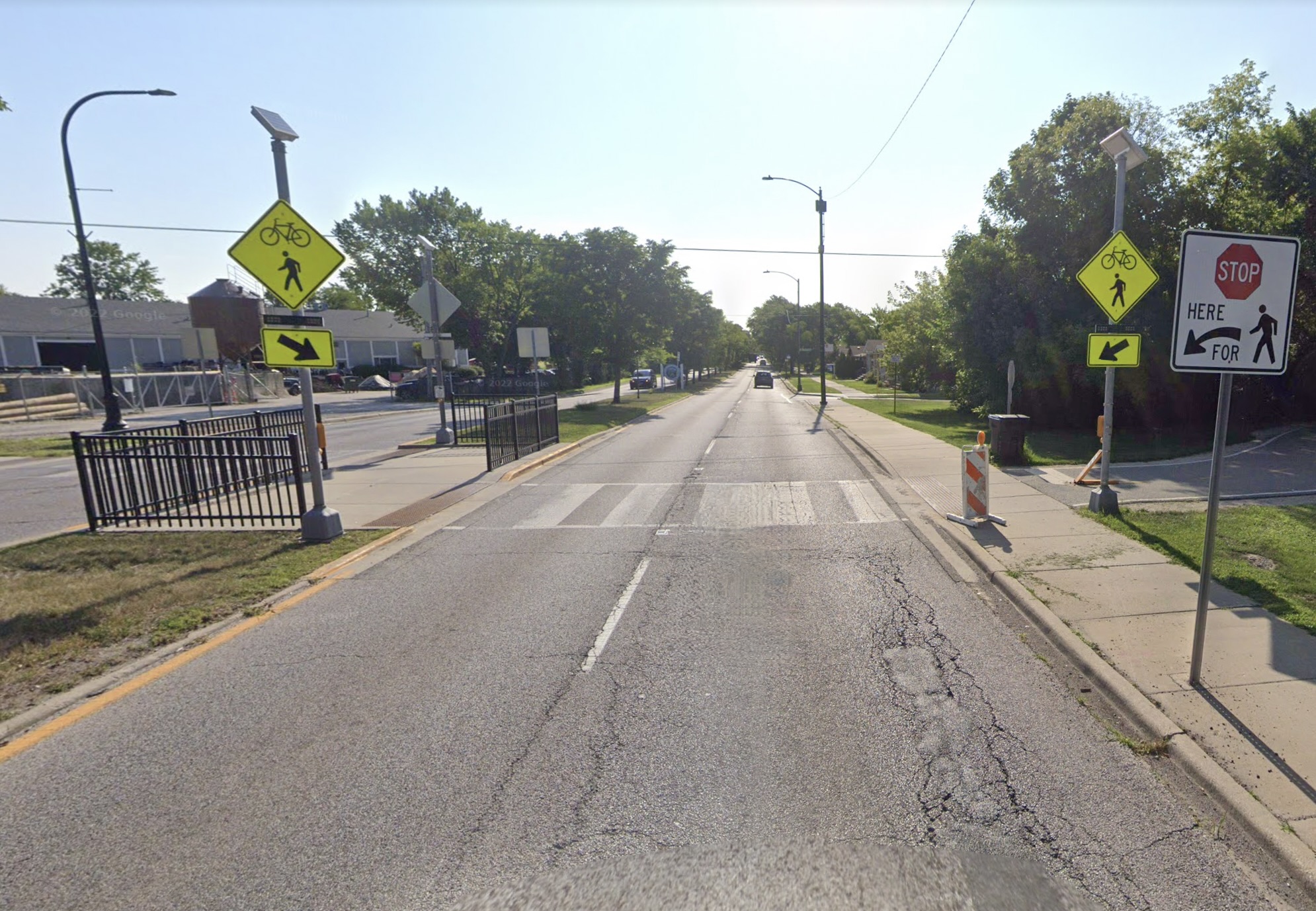Tragically, a young bicycle rider is fighting for his life after an elderly sedan driver struck him in the intersection of a bike trail and a four-lane road Monday afternoon in Chicago's Far North Sauganash neighborhood. The case raises at least two issues. Are Rectangular Rapid Flashing Beacons, warning signals that cyclists and pedestrian can activate before using a no-stoplight crosswalk, really a sound design strategy for crossings like this? And why does Chicago have a transportation system that puts pressure on seniors to drive cars after it may no longer be safe for them to do so?
According to the initial Chicago Police Department statement, on Monday, August 21 around 3:30 p.m. the bike rider, a 27-year-old man, was "traveling southbound on Kostner" Avenue (4400 W.) when the 92-year-old female Chevrolet driver traveling east on Devon Avenue (6400 W.) struck him. The victim was taken to St. Francis Hospital in critical condition.
Wednesday afternoon the Cook County medical examiner's office said they have not been notified about the case, which suggests the man was still alive.
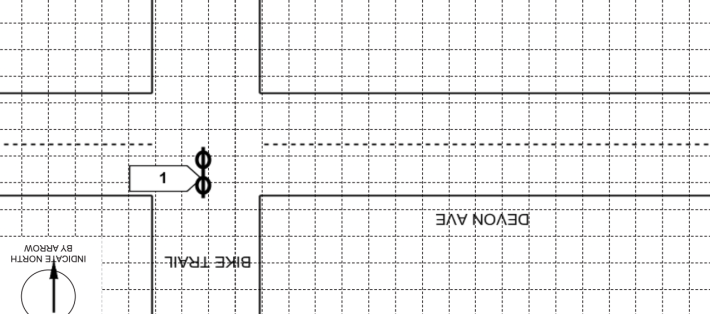
The traffic crash report provides more information about what reportedly happened. As I suspected yesterday, the report confirms that the bike rider was not biking south on Kostner when he was struck, because Kostner doesn't exist north of Devon at this locations. Rather, he was riding on the Valley Line Trail bike path, which, south of Devon, is located just west of Kostner. The Devon trail crossing has RRFB signals that trail users can activate.
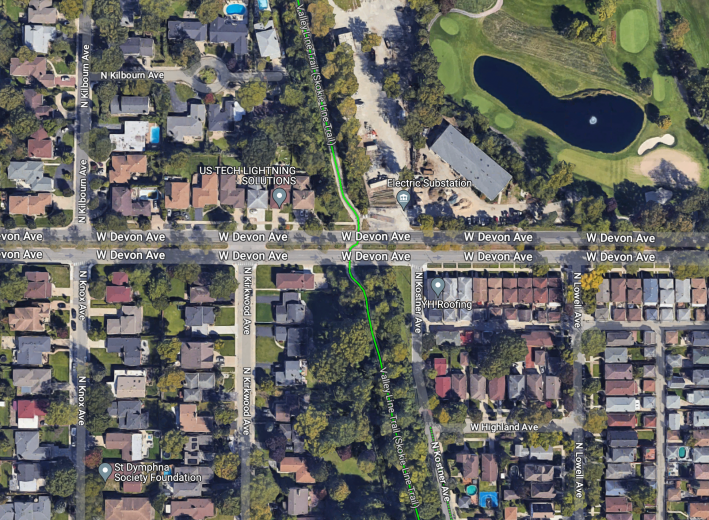
"[The driver] was traveling eastbound on Devon Avenue when they struck [the bike rider] who was traveling southbound on a bike trail that intersects with Devon," the report states. "There was conflicting information from witnesses as to whether the the flashing light on the bike trail was on when [the bike rider] crossed."
Three witnesses are listed on the report. There are two men with the same last name who are listed at the same address 3.5 miles northeast of the crash site in the West Ridge community area. The third witness is man who is listed at an address a couple of blocks southwest of the collision location in Sauganash.
The report lists the victim at an address 6.5 miles southwest of the crash site in the Austin neighborhood. The driver is listed at an address 1.5 miles southeast of the collision location in the North Park community area. (Streetsblog Chicago generally does not publish the names and exact address of people involved in crashes or witnesses if they are listed in crash reports but this info has not been publicized by CPD and/or the medical examiner.)
According to the report, the victim suffered "multiple rib fractures, a collapsed lung, cardiac contusions, and small bleeds of the brain."
This crash once again raises the issue of whether Rectangular Rapid Flashing Beacons are really a safe strategy for bike-pedestrian routes crossing major streets. As Streetsblog Chicago discussed last January, this treatment, similar to a HAWK beacon, includes a push button that people on foot and bike can use to activate flashing lights on either side of a crosswalk, alerting drivers to the presence of people in the crossing. RRFPs are relatively rare in the city of Chicago, but they do exist at a few locations, such as the mid-block crossing on Monroe Street (100 S.) east of Michigan Avenue (100 E.) between the Art Institute of Chicago museum and Millenium Park.
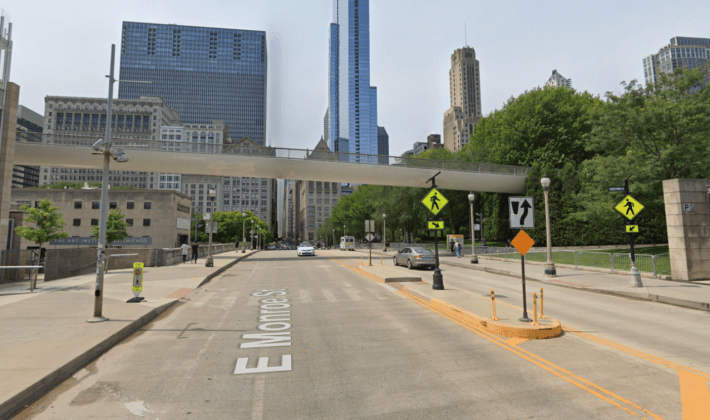
One problem with RRFBs is that the beacons are not equivalent to a stoplight and drivers are not required to stop when they see the flashing lights unless a bike rider or pedestrian is already in the crosswalk. That's the same as what they would be mandated to do by Illinois law for people in any crosswalk that does not have RRFBs.
And while the beacons help raise driver awareness of crosswalks, people on bike and foot must still be wary of the fact that, despite the state law, motorists often fail to stop for people in crosswalks, especially on multilane roads like Devon where speeding is common. Even the flashing lights won't guarantee that all drivers will behave responsibly.
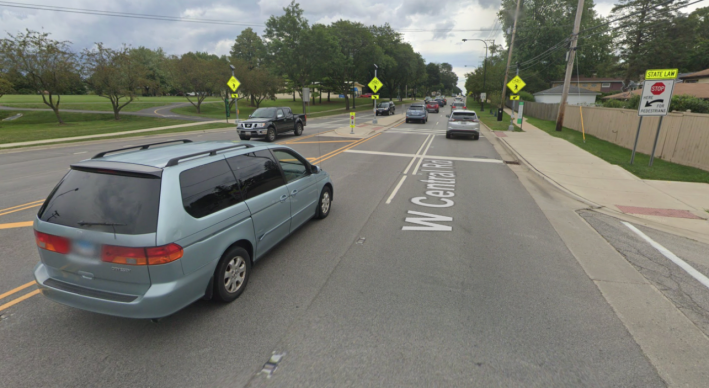
Sadly, that issue was laid bare in June 2016, when a negligent driver fatally struck Joni Beaudry, 55, on her bike at an RRFB crosswalk in surban Mount Prospect. According to witnesses, after leaving a bike path in a park, the cyclist activated the beacons on four-lane Central Road before crossing southbound towards Weller Lane. After three eastbound motorists stopped for her, she probably assumed it was safe to ride across Central.
That's when a eastbnound SUV driver hit her. That motorist admitted she was speeding and wasn't wearing her required corrective lenses, but claimed she didn't see the flashing lights or Beaudry before the bike rider was in front of her vehicle. If there had been a cyclist-pedestrian-activated stoplight at this intersection instead of an RRFB, it's far less likely that the SUV driver would have disobeyed it.
This principal is also true for the recent Sauganash crash. If the Devon / Valley Line Trail had a stoplight instead RRFBs, the bike rider probably wouldn't grievously injured right now.
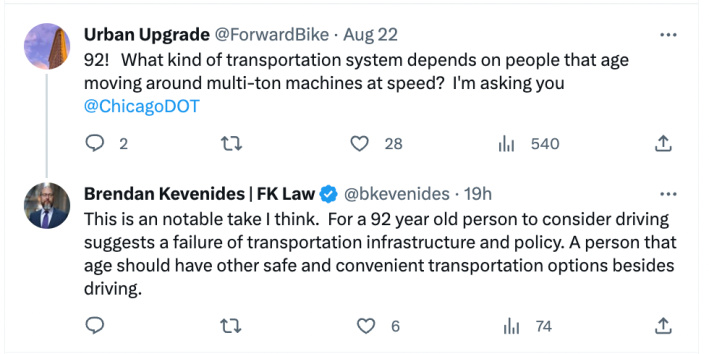
As Streetsblog readers noted on Twitter, this case also raises the question of why a 92-year-old person felt the need to operate a car, let alone drive on a high-speed four-lane street. In cities around the world with much lower traffic injury and fatality rates than Chicago, the street designs and transportation policies are such that seniors have safe, convenient alternatives to driving: walking, transit, and, yes, biking.

Did you appreciate this post? Please consider making a tax-deductible donation.
